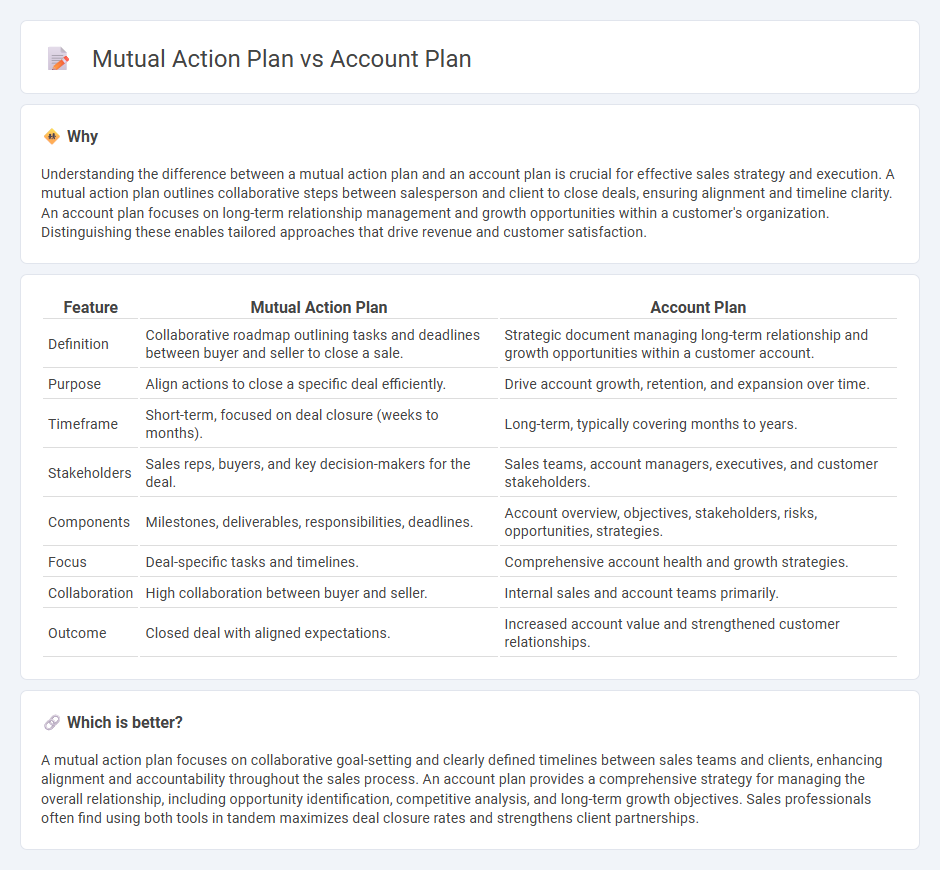
A mutual action plan clearly outlines collaborative steps between sales teams and clients to achieve shared goals, focusing on timelines and responsibilities. Account plans emphasize comprehensive strategies for managing key customer relationships, including growth opportunities and risk management. Explore how combining these approaches can enhance sales effectiveness and client satisfaction.
Why it is important
Understanding the difference between a mutual action plan and an account plan is crucial for effective sales strategy and execution. A mutual action plan outlines collaborative steps between salesperson and client to close deals, ensuring alignment and timeline clarity. An account plan focuses on long-term relationship management and growth opportunities within a customer's organization. Distinguishing these enables tailored approaches that drive revenue and customer satisfaction.
Comparison Table
| Feature | Mutual Action Plan | Account Plan |
|---|---|---|
| Definition | Collaborative roadmap outlining tasks and deadlines between buyer and seller to close a sale. | Strategic document managing long-term relationship and growth opportunities within a customer account. |
| Purpose | Align actions to close a specific deal efficiently. | Drive account growth, retention, and expansion over time. |
| Timeframe | Short-term, focused on deal closure (weeks to months). | Long-term, typically covering months to years. |
| Stakeholders | Sales reps, buyers, and key decision-makers for the deal. | Sales teams, account managers, executives, and customer stakeholders. |
| Components | Milestones, deliverables, responsibilities, deadlines. | Account overview, objectives, stakeholders, risks, opportunities, strategies. |
| Focus | Deal-specific tasks and timelines. | Comprehensive account health and growth strategies. |
| Collaboration | High collaboration between buyer and seller. | Internal sales and account teams primarily. |
| Outcome | Closed deal with aligned expectations. | Increased account value and strengthened customer relationships. |
Which is better?
A mutual action plan focuses on collaborative goal-setting and clearly defined timelines between sales teams and clients, enhancing alignment and accountability throughout the sales process. An account plan provides a comprehensive strategy for managing the overall relationship, including opportunity identification, competitive analysis, and long-term growth objectives. Sales professionals often find using both tools in tandem maximizes deal closure rates and strengthens client partnerships.
Connection
A mutual action plan aligns the collaborative steps between sales teams and clients, ensuring clear milestones and shared responsibilities. An account plan provides a comprehensive strategy for managing customer relationships, identifying opportunities, and addressing challenges. Together, these plans create a cohesive framework that drives sales success by synchronizing strategic goals with actionable tasks.
Key Terms
**Account Plan:**
An Account Plan focuses on strategic management of client relationships by detailing objectives, key contacts, and tailored solutions to maximize revenue and long-term engagement. It emphasizes understanding client needs, market positioning, competitive landscape, and growth opportunities to align company resources effectively. Explore how an Account Plan drives personalized strategies for sustained business success.
Customer Objectives
Account plans concentrate on long-term customer objectives by outlining strategic goals, resource allocation, and performance metrics tailored to foster sustained growth and partnership. Mutual action plans emphasize collaborative milestones and shared responsibilities between the customer and provider, ensuring aligned timelines and transparent progress tracking. Discover how integrating both approaches can enhance customer success by aligning objectives and execution strategies effectively.
Stakeholder Mapping
Account plans emphasize comprehensive stakeholder mapping to identify key decision-makers, influencers, and economic buyers across the organization, enabling targeted engagement strategies. Mutual action plans focus on collaborative stakeholder alignment by defining joint responsibilities, timelines, and success criteria to ensure all parties remain accountable and engaged. Explore the strategic differences in stakeholder mapping to optimize relationship management and deal progression.
Source and External Links
Your Guide to Account Planning in B2B Sales - Account planning is a strategic process that maps out key details about prospects or customers, focusing on objectives, relationship mapping, expansion opportunities, and actionable steps to drive revenue and loyalty in B2B sales.
The Fundamental Guide to Account Planning - A key account plan is a methodical strategy to manage and grow key client relationships, incorporating account overview, long-term objectives, action plans, and change management processes to sustain and expand business.
How To Create Account Plans That Work | 10 Best Practice ... - Effective account planning follows a structured four-step approach, including territory segmentation, relationship development, and managing multiple plans for complex customers to cover strategic buying units within large organizations.
 dowidth.com
dowidth.com